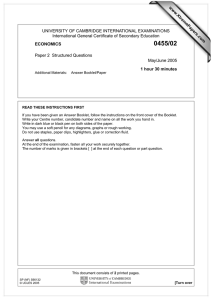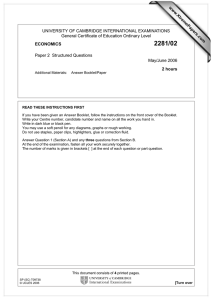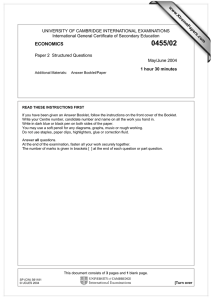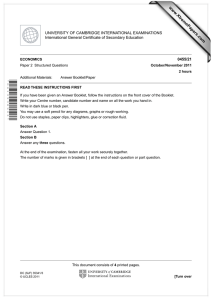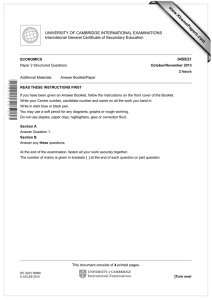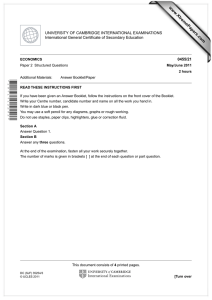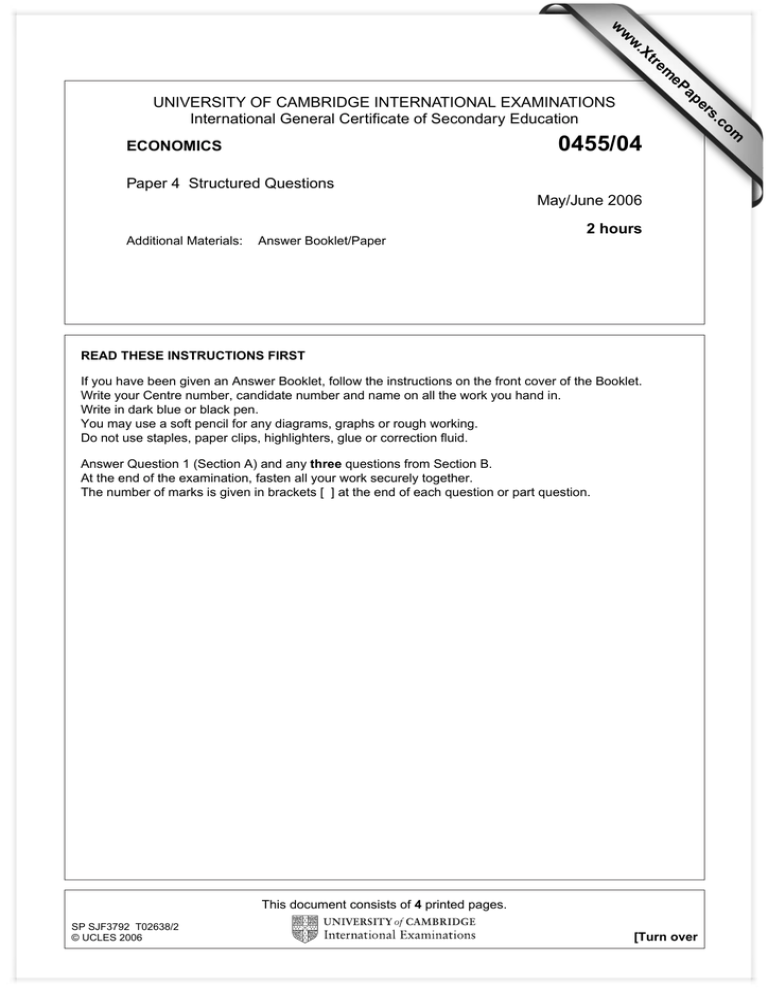
w
w
ap
eP
m
e
tr
.X
w
0455/04
ECONOMICS
Paper 4 Structured Questions
May/June 2006
2 hours
Additional Materials:
Answer Booklet/Paper
READ THESE INSTRUCTIONS FIRST
If you have been given an Answer Booklet, follow the instructions on the front cover of the Booklet.
Write your Centre number, candidate number and name on all the work you hand in.
Write in dark blue or black pen.
You may use a soft pencil for any diagrams, graphs or rough working.
Do not use staples, paper clips, highlighters, glue or correction fluid.
Answer Question 1 (Section A) and any three questions from Section B.
At the end of the examination, fasten all your work securely together.
The number of marks is given in brackets [ ] at the end of each question or part question.
This document consists of 4 printed pages.
SP SJF3792 T02638/2
© UCLES 2006
[Turn over
om
.c
s
er
UNIVERSITY OF CAMBRIDGE INTERNATIONAL EXAMINATIONS
International General Certificate of Secondary Education
2
Section A
Answer this question.
1
Demand for oil in India
India is the world’s seventh-largest consumer of oil. Demand for oil could more than double in the
next 15 years because of strong industrial growth and increasing numbers of Indians who will be
able to afford to buy cars and motorcycles. As demand grows, so will India’s dependence on
imports. India imports around 70% of its oil.
(a) Explain using a demand and supply diagram what the article says will be the likely change in
the market for oil in India in the next 15 years.
[5]
(b) (i)
Where would the purchase of foreign oil be recorded in India’s balance of payments? [3]
(ii)
Explain two possible disadvantages to the Indian economy of its dependence on
imported oil.
[4]
(c) The article says there will be ‘strong industrial growth’.
(i)
Explain what is meant by strong industrial growth.
[2]
(ii)
Discuss the possible effects of strong industrial growth.
[6]
© UCLES 2006
0455/04/M/J/06
3
Section B
Answer three questions.
2
3
Sometimes in an industry a firm buys a smaller competitor which uses similar factors of
production. At other times a firm buys another firm which supplies it with the raw materials and
other inputs for its production.
(a) Explain what is meant by the factors of production.
[4]
(b) Discuss the reasons why some firms remain small.
[6]
(c) Identify the types of integration in the two situations described above.
[3]
(d) Discuss whether such integration is always beneficial.
[7]
(a) Explain the terms scarcity and opportunity cost.
[4]
(b) Describe the factors that affect an individual’s choice of occupation and show how the idea of
opportunity cost might be relevant to that choice.
[6]
4
(c) Analyse how a person’s earnings are likely to change during their working life.
[4]
(d) Discuss why different occupations have different rates of pay.
[6]
Australia’s unemployment rate fell to 5.5% in May 2004, the lowest for 23 years. At the same time
total employment decreased to 9.6 million. Full-time jobs decreased by 42 600 but part-time
employment rose by 1500. The shift from employment in agriculture and manufacturing to
services has continued.
(a) Calculate the change in total employment. (Show your working).
[2]
(b) Explain why the pattern of employment might change.
[8]
(c) The above extract says that the unemployment rate fell yet the numbers employed
decreased. Explain how these statements can both be true at the same time.
[3]
(d) Discuss the economic consequences of unemployment.
© UCLES 2006
0455/04/M/J/06
[7]
[Turn over
4
5
(a) Distinguish between the private sector and the public sector of an economy.
[3]
(b) Discuss the disadvantages of allocating resources through the public sector.
[7]
The Singapore government plans to build Asia’s first airport dedicated to serving low-cost
airlines. Its estimated cost is $26.5 million and it will be designed to handle about 2.7 million
passengers each year.
(c) When airports are planned, there are usually some people who campaign to stop them being
built. What disadvantages might the building of an airport have?
[4]
(d) A government is considering paying for a similar airport by either increasing income tax or
introducing a specific (flat-rate) tax on air passengers. Discuss which of these you would
favour.
[6]
6
A recent journal article stated that poor nations should be allowed to protect their new industries
from foreign competition.
(a) Explain what indicators might be used to determine that a nation is poor.
[8]
(b) Describe what methods might be used to protect industries from foreign competition in
international trade.
[5]
(c) Discuss whether it is better for a country to engage in free trade or to use some form of
protection from foreign competition.
[7]
7
(a) The rate of population growth in developed countries is often different from the rate of
population growth in developing countries. Explain why this might be so.
[5]
(b) Sometimes a government might try to limit the growth in the population of its country. Explain
why it might want to do this.
[4]
(c) As countries become more economically developed, there is a change in the relative
importance of the different sectors of production. Describe what this change might be.
[5]
(d) In many developed countries there will be a large increase in the proportion of older people
during the next 10 to 15 years. Discuss how governments might deal with this situation. [6]
Copyright Acknowledgements:
Question 1
Question 4
Reprinted with permission of Far Eastern Economic Review, Copyright © (2004) Dow Jones & Company, Inc. All rights Reserved Worldwide.
Reprinted with permission of Far Eastern Economic Review, Copyright © (2004) Dow Jones & Company, Inc. All rights Reserved Worldwide.
Permission to reproduce items where third-party owned material protected by copyright is included has been sought and cleared where possible. Every
reasonable effort has been made by the publisher (UCLES) to trace copyright holders, but if any items requiring clearance have unwittingly been included, the
publisher will be pleased to make amends at the earliest possible opportunity.
University of Cambridge International Examinations is part of the University of Cambridge Local Examinations Syndicate (UCLES), which is itself a department of
the University of Cambridge.
© UCLES 2006
0455/04/M/J/06





